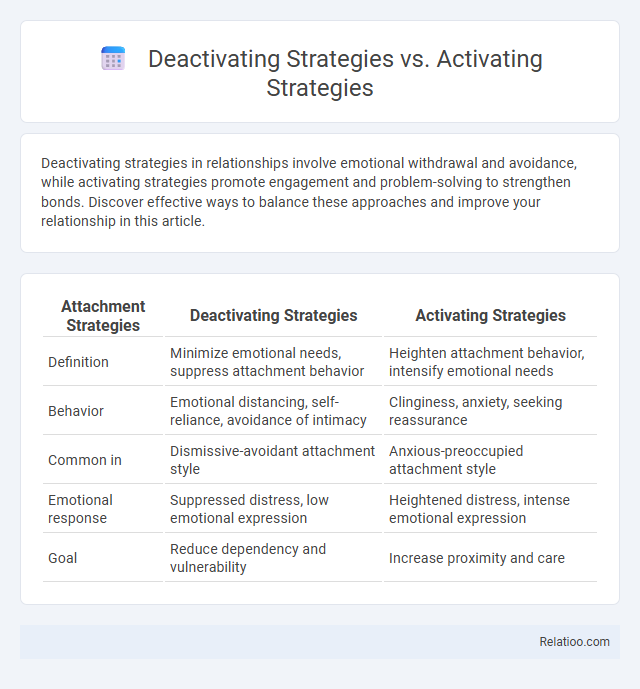Deactivating strategies in relationships involve emotional withdrawal and avoidance, while activating strategies promote engagement and problem-solving to strengthen bonds. Discover effective ways to balance these approaches and improve your relationship in this article.
Table of Comparison
| Attachment Strategies | Deactivating Strategies | Activating Strategies |
|---|---|---|
| Definition | Minimize emotional needs, suppress attachment behavior | Heighten attachment behavior, intensify emotional needs |
| Behavior | Emotional distancing, self-reliance, avoidance of intimacy | Clinginess, anxiety, seeking reassurance |
| Common in | Dismissive-avoidant attachment style | Anxious-preoccupied attachment style |
| Emotional response | Suppressed distress, low emotional expression | Heightened distress, intense emotional expression |
| Goal | Reduce dependency and vulnerability | Increase proximity and care |
Understanding Deactivating Strategies
Deactivating strategies involve cognitive and behavioral techniques aimed at reducing physiological arousal and emotional intensity, such as deep breathing, progressive muscle relaxation, and mindfulness meditation. These strategies target the parasympathetic nervous system to induce calmness and prevent stress escalation, thereby enhancing emotional regulation and resilience. Understanding deactivating strategies is crucial for effectively managing anxiety, post-traumatic stress, and emotional dysregulation in therapeutic and everyday contexts.
What Are Activating Strategies?
Activating strategies refer to methods designed to stimulate or enhance cognitive, emotional, or physiological responses, promoting engagement and motivation in various contexts such as learning, therapy, or performance enhancement. Your ability to effectively implement activating strategies can improve focus, increase alertness, and drive positive behavioral changes by encouraging proactive participation. Understanding the difference between activating strategies and deactivating strategies, which aim to reduce arousal or stress, is key to applying the correct approach for specific goals.
Core Differences: Deactivating vs Activating Strategies
Deactivating strategies aim to reduce or suppress emotional arousal and physiological activation, often through avoidance or withdrawal behaviors, whereas activating strategies seek to increase engagement and stimulate action toward goals or emotional processing. The core difference lies in their opposite motivational directions: deactivating strategies minimize emotional intensity and drive, while activating strategies enhance motivation and promote adaptive coping mechanisms. Understanding these distinctions is crucial for tailoring interventions in psychological therapies and stress management practices.
Psychological Foundations of Each Approach
Deactivating strategies in psychology involve suppressing or avoiding emotional responses to reduce immediate distress, relying on cognitive control and emotional regulation mechanisms rooted in the prefrontal cortex. Activating strategies engage individuals in confronting and processing emotions directly, utilizing acceptance and exposure principles grounded in the limbic system and associated neural pathways. Deactivation refers to the psychological and physiological downregulation of emotional arousal, often mediated by parasympathetic nervous system activation and adaptive coping processes within the stress response framework.
Benefits of Deactivating Strategies
Deactivating strategies reduce emotional intensity by shifting attention away from stressors, promoting mental calmness and preventing rumination. These strategies improve emotional regulation and resilience, contributing to lower anxiety and enhanced psychological well-being. Effective deactivation supports long-term stress management and healthier cognitive processing in challenging situations.
Advantages of Activating Strategies
Activating strategies boost engagement and motivation by stimulating proactive behavior and enhancing cognitive performance, leading to improved learning outcomes and creativity. Your ability to implement activating strategies can drive increased productivity and foster a dynamic environment where innovation thrives. These approaches outperform deactivating strategies by promoting sustained focus and resilience in challenging situations.
When to Use Deactivating Strategies
Deactivating strategies are most effective in situations requiring immediate reduction of emotional arousal, such as during acute stress or conflict, helping to restore emotional balance quickly. These strategies involve techniques like deep breathing, mindfulness, or cognitive distancing to calm the nervous system and prevent impulsive reactions. Activating strategies, by contrast, are better suited for motivation and goal pursuit, while deactivation refers to the physiological or psychological state achieved after successfully applying deactivating techniques.
Situations Suited for Activating Strategies
Situations suited for activating strategies typically involve moments requiring increased alertness, motivation, or performance enhancement, such as before competitive sports events, high-pressure presentations, or urgent problem-solving tasks. Activating strategies boost physiological arousal and cognitive focus, aligning your mental and physical state with the demands of challenging scenarios. Deactivating strategies, in contrast, aim to reduce stress and promote relaxation, while deactivation refers to the overall process of lowering arousal levels when calmness is necessary.
Common Pitfalls of Each Strategy
Deactivating strategies often suffer from avoidance behaviors that can lead to unresolved conflicts and emotional suppression, reducing overall relationship satisfaction. Activating strategies may result in overreacting or escalating issues due to heightened emotional expression without effective regulation, causing further interpersonal tension. Deactivation as a coping mechanism can create emotional distancing and withdrawal, hindering genuine connection and trust-building between partners.
Choosing the Right Strategy for Your Goals
Choosing the right strategy for your goals depends on understanding the impact of deactivating strategies, which reduce physiological arousal and calm the nervous system, versus activating strategies that increase energy and focus through stimulation. Deactivation involves the process of reducing stress responses to restore balance, critical for recovery and mental clarity. Your decision should align with whether your goal requires relaxation and downtime or increased alertness and motivation.

Infographic: Deactivating Strategies vs Activating Strategies
 relatioo.com
relatioo.com